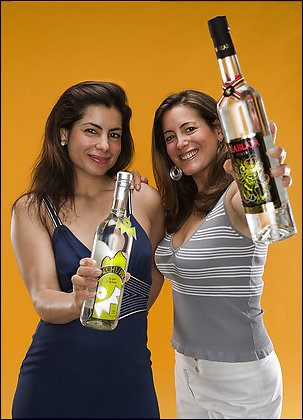Making It
September 7, 2008 - Washington Post
By Vanessa M. Gezari
As a child in Lima, Peru, Melanie Asher planted weeds in bottle caps and peddled them to neighbors. In middle school in Bethesda, when other girls were swooning over David Hasselhoff, Melanie had a picture of Donald Trump in her locker. Her entrepreneurial leanings crystallized at 12, when she drizzled a few drops of pisco, a Peruvian brandy favored by her relatives, over a bowl of ice cream and decided she wanted to sell the liquor one day. "Everyone was aghast," Melanie recalls. "'Our little daughter is going into the liquor business!'"
 (left) FLAVOR OF PERU: Lizzie Asher, left, and her sister, Melanie, are introducing the country's pisco brandy to new markets. (Phto: Copyright Keith Barraclough)
(left) FLAVOR OF PERU: Lizzie Asher, left, and her sister, Melanie, are introducing the country's pisco brandy to new markets. (Phto: Copyright Keith Barraclough)
Now 33, Melanie has succeeded in bringing the clear, strong brandy that Peruvian villagers drink from a single shared glass to bars and restaurants in the United States. Born in Peru, she and her sister, Lizzie Asher, 36, fantasized about making their own pisco during summer vacations in Lima and late-night chats in their shared bedroom in Bethesda, where they moved in the early 1980s. They started MacchuPisco in 2004 and last year became the nation's largest importer of Peruvian pisco, with a distillery in Peru, a warehouse in Rockville and an office in the basement of their mother's home.
"The notion of creating MacchuPisco was to bring pisco to the world," Melanie says. "It has its own unique buzz. Tequila I don't remember the next day. Pisco gives you a nice little uplift."
Developing the business has been a decades-long project. At Duke University, Melanie wrote her thesis on Prohibition. As a young investment banker at Citigroup, she advised Jose Cuervo. At Harvard business school, she developed a plan to launch her own brand of pisco, Peru's national drink, which had fallen into relative obscurity in the United States.
Distilled from grapes planted by Spanish colonists, pisco arrived in California during the gold rush. Mark Twain and Rudyard Kipling drank it, and Kipling mused that pisco punch, a concoction of pisco and pineapple juice, was "compounded of the shavings of cherubs' wings, the glory of a tropical dawn, the red clouds of sunset, and fragments of lost epics by dead masters."
Pisco resurfaced after Prohibition, when the pisco sour, a cocktail made with lime juice and egg whites, became popular. Today Washington area residents can sample versions made with MacchuPisco or the Ashers' premium blend, La Diablada, at Clyde's in Georgetown, Las Canteras in Adams Morgan and PX, a hip cocktail bar in Alexandria.
ad_icon
"It's my favorite thing to drink," says Todd Thrasher, a bartender at PX. "A lot of people think it's grappa, and grappa to me is really hard to drink. But I tell them it's made from wine, and I let them try it themselves because it's really, really smooth."
Melanie and Lizzie started Macchu-Pisco with a $100,000 gift from their father, who recently died, as well as money from other relatives and their own savings. After $500,000 in start-up costs, mainly for marketing and product development, they broke even in 2007 and have netted $80,000 this year, Melanie says.
Melanie, single and still living in Bethesda, spends several months per year in Peru overseeing production. Lizzie, married and living in New York, is MacchuPisco's chief legal counsel and models in its brochures. "It has forced us all to be very cooperative with each other," Melanie says. "I knew what I wanted to do, but an idea's an idea. I'm fortunate that my family supported me."